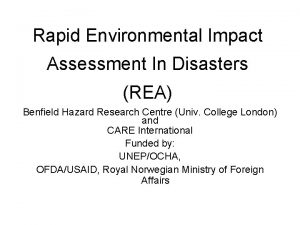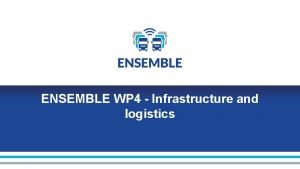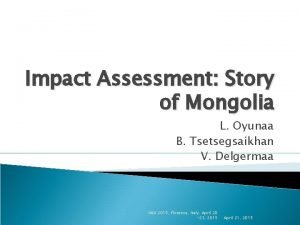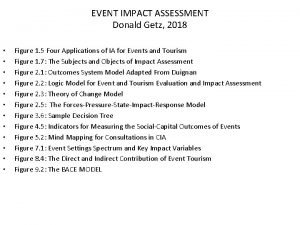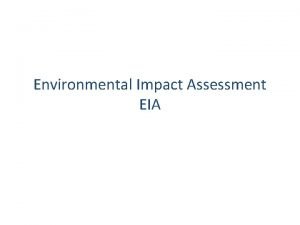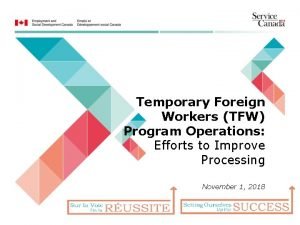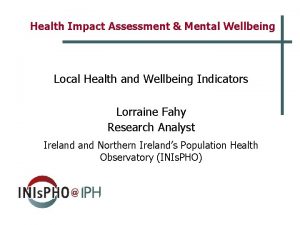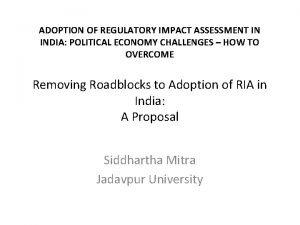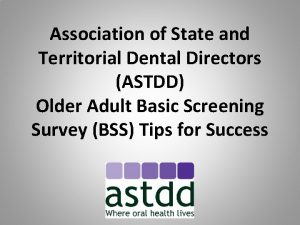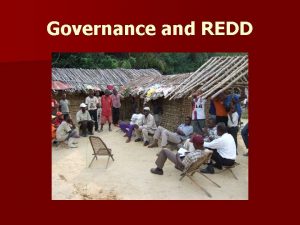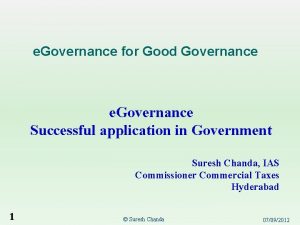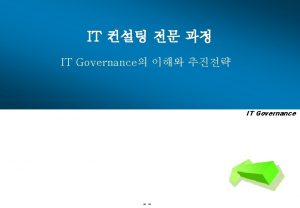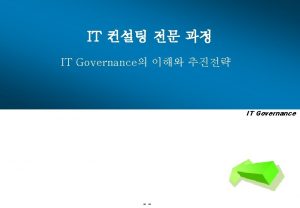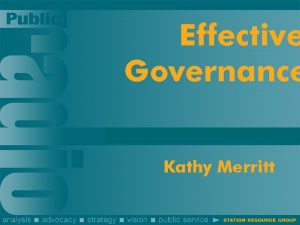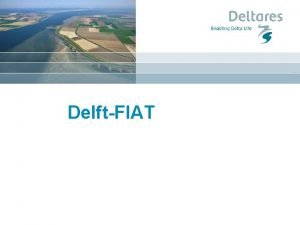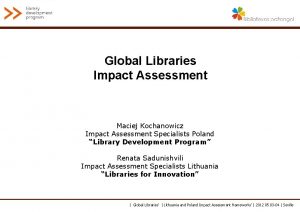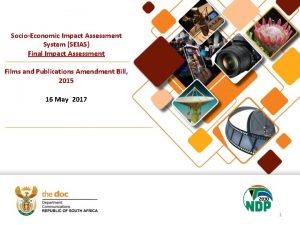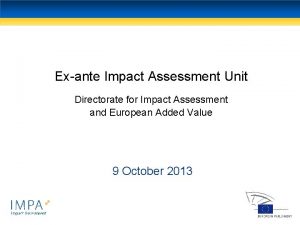Territorial Impact Assessment of Governance of Territorial and



























- Slides: 27

Territorial Impact Assessment of Governance of Territorial and Urban Policies in ESPON Space ESPON PROJECT 2. 3. 2: GOVERNANCE OF TERRITORIAL AND URBAN POLICIES FROM EU TO LOCAL LEVEL Luxembourg, 14 th October 2005 Joaquín Farinós Dasí University of Valencia

A very particular topic of research • Governance is not a policy but a way of design and applies different policies with territorial impact • Territorial and urban are spatial based policies • Tailored application of TIA, adapted to … … … unavailability of statistical data and indicators difficult to define an ‘a priori’ hypothesis not possible nor convenient to ‘encapsulate’ governance ‘a priori’ inductive/qualitative approach especially appropriate integration inductive (hypothesis formulation) and deductive (test) benchmarking in order to learn about reasons of good and failed examples and their possible transferability • Appropriate level: State (National vs. State). Regions/NUTS 3? • Original project that uses experience we are gaining as a source and base to help build theory concerning governance and territorial cohesion

Two ways to understand the topic • Territorial Governance can be seen as a simple application in the urban and territorial field of general principles of governance or, • As a process with specific features because its object is the territory and its aims to manage territorial dynamics through the pilotage of a multiplicity of actors sharing a common agreed objective (spatial visions to improve territorial cohesion at different levels ) • The second one is more strategic but much more difficult to assess for which qualitative data and inductive methods can be very useful • We try to cover both perspectives in our project, however constraints of data, time and resources impose limits that only allows, in some cases, to find out hypothesis for future developments

Operational definition of governance and formulation of hypothesis

Primary Hypotheses • principles of good governance have positive impact over a territory; that is, governance practices should improve territorial cohesion objective - impacts in GDP/GVA, employment, welfare and public services and sustainability • it is possible to recognize and assess factors that characterize good governance (prerequisites, “mechanisms”); they could be “transferables” • some specific territorial features and dynamics also as institutional frameworks of territorial and urban policies have positive effects - good governance is mainly to be assessed on a territory-basis

Types of indicators/criteria Context To describe To evaluate Policies To describe Territorial features and dynamics Favourable territorial preconditions Institutional frameworks of territorial policies Processes TGAs To evaluate Results

Methodological Overview

The need of integrating Quantitative – Qualitative Approaches BENCHMARKING S C A L E S Available Data + Data collection POLICY RECOMENDATIONS COMPARISON: Analyse potential impacts of Good Governance on Urban & Territorial Policies

Method in National Overviews: Context update • NOs and CSs constitute, as sequential steps, the way in which we try to know territorial governance in its three dimensions: as structure (or preconditions for governance), as process and as results. • Information from the NOs was exploited and organized in a systematized way, mainly through tabulation in semi-closed tables with limited alternatives for answers. - as a result a Synthesis Report was elaborated - national information was tested in a second round with national writers - this information was placed by countries into a matrix (‘yes/not’) - the matrix was again circulated among TPG members - this matrix was the starting point to mapping

Mapping Exercise *Governance Score calculated summing up the result of the Score components of five headers of National Overviews: 1) official acceptance of governance and principles, 2) changes in formal government in the direction of governance, 3) Experience with participation processes, 4) experience with partnerships, 5) extent of financial dependence of local government on central government.

Method in National Overviews: Context update • So, it was followed a continued system of mutual assessment (insider investigator triangulation method) between TPG (broadest in ESPON 1), Working Package responsible and Project Coordination • Open questions for NOs: - improve systematisation of all amount of information & identify main/key issues - contrast for agreement following a Delphi method (closer to theory triangulation method) between: 232 project, other related ESPON projects and national experts from ESPON Contact Points • Limits: time and resources, and previous failed experiences in other ESPON projects. • Next research steps concentrated on specific issues considered more consistent (in a comparative way) while others remain for future developments.

Specific Issues from National Overviews for Case Studies · As structural conditions - Changes in formal government in the direction of governance · - Priority emphasis on governance objectives as indicated in NO · - Conditions leading to shifts towards governance: Positive elements are: · long tradition of “working together” and citizens’ participation, · innovations in the field of partnership creation, · reorganization of spatial planning system and · introduction of new instruments and agencies · - Catalysts and barriers to changes to governance · CSs mainly focus in governance as process

Collecting Data from EU and National Statistical Sources (1/2)

Collecting Data from EU and National Statistical Sources (2/2)

Matrix for Case Studies Proposal

Case Studies Map

Guidelines for Case Studies

‘Numeric’ approach towards Case Studies (1/5)

‘Numeric’ approach towards Case Studies (2/5)

‘Numeric’ approach towards Case Studies (3/5)

‘Numeric’ approach towards Case Studies (4/5)

‘Numeric’ approach towards Case Studies (5/5)

Looking for Data and Indicators * Space has to be seen as an encompassing category

Starting set of Indicators

Starting set of Indicators (*) Delta valuates difference between two data or two reference points) ** The indicators on spatial aspects are used to further differentiate the regional situation. Source: IRPUD

LOOKING FOR A REGIONAL TYPOLOGY • By combining the structural with the dynamic indicators we might at least achieve a typology of regions

Thank you for your attention!!
 Eia ktu syllabus
Eia ktu syllabus Business continuity software integration with hp
Business continuity software integration with hp Cipd assessment examples
Cipd assessment examples Rapid environmental impact assessment in disaster
Rapid environmental impact assessment in disaster Traffic impact assessment
Traffic impact assessment Change impact assessment template
Change impact assessment template Environmental impact assessment
Environmental impact assessment Event impact assessment
Event impact assessment Environmental auditing
Environmental auditing Lmia online pilot
Lmia online pilot Mental wellbeing impact assessment
Mental wellbeing impact assessment Mental wellbeing impact assessment
Mental wellbeing impact assessment Regulatory impact assessment india
Regulatory impact assessment india B.i.ø
B.i.ø Astdd
Astdd Chapter 12 territorial and economic expansion
Chapter 12 territorial and economic expansion Territorial and economic expansion
Territorial and economic expansion Chapter 10 section 1 building a german nation
Chapter 10 section 1 building a german nation Stages in implementing portfolio assessment
Stages in implementing portfolio assessment Define dynamic assessment
Define dynamic assessment Portfolio assessment matches assessment to teaching
Portfolio assessment matches assessment to teaching Data governance and risk management
Data governance and risk management Informational and behavioral control
Informational and behavioral control Oracle grc
Oracle grc Hr governance risk and compliance
Hr governance risk and compliance Hpe information management and governance
Hpe information management and governance Global systems and global governance exam questions
Global systems and global governance exam questions Master data management roadmap ppt
Master data management roadmap ppt



